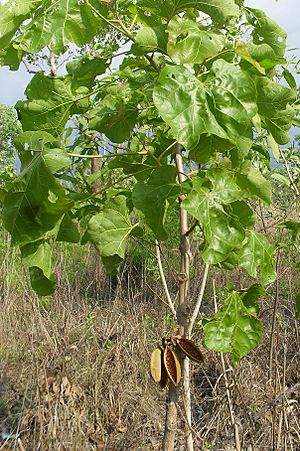Red-flowering kurrajong facts for kids
The red-flowering kurrajong (scientific name: Brachychiton megaphyllus) is a beautiful tree found in northern Australia. It's known for its bright orange-red flowers. This tree is part of the Brachychiton family, which includes many interesting Australian plants.
Scientists officially described this tree in 1988. Before that, some thought it was just a different type of another tree called Brachychiton paradoxus. Sometimes, this tree can even mix with another type, Brachychiton multicaulis, to create new kinds of plants!
Quick facts for kids Red-flowering kurrajong |
|
|---|---|
 |
|
| Scientific classification | |
| Genus: |
Brachychiton
|
| Species: |
megaphyllus
|
Contents
About the Red-Flowering Kurrajong
What it Looks Like
The red-flowering kurrajong can grow as a large bush or a small tree. It usually reaches about 2 to 8 meters (6 to 26 feet) tall. Its trunk can be 10 to 25 centimeters (4 to 10 inches) wide. The bark is dark brown and has lines and small patterns on it.
Like all trees in its family, its leaves grow in a special pattern, one after another along the stems. The leaves are quite big, shaped like an oval or having three lobes. They are about 15 to 26 centimeters (6 to 10 inches) long and 13 to 24 centimeters (5 to 9 inches) wide. The bottom of the leaf looks like a heart.
Flowers and Seeds
This tree is deciduous, which means it loses its leaves every year. It's usually bare from June to September. Its bright orange-red flowers appear from June to October, or sometimes even November.
After the flowers, the tree grows woody seedpods called follicles. These pods are yellow-brown and mature between September and June. They are about 6.5 to 11 centimeters (2.5 to 4.3 inches) long and 3 to 4.8 centimeters (1.2 to 1.9 inches) wide. When they open, they show 25 to 45 seeds inside. The seeds are oval-shaped, smooth, and about 8 to 9 millimeters long. They are covered in a hairy layer.
Where it Grows
The red-flowering kurrajong is found in the Northern Territory of Australia. You can find it north of the 17th parallel south latitude. It often grows in open forests where Eucalyptus trees are common, especially with Eucalyptus miniata and Darwin stringybark. It usually prefers red soils that come from a type of rock called laterite.
How People Use This Tree
Cultural Importance
For the Ngan’gityemerri people, the flowering of the red-flowering kurrajong is a special sign. It tells them that freshwater crocodiles are laying their eggs.
This tree is also popular for planting in gardens in the Northern Territory. In 1988, it became the official plant emblem of the city of Darwin.
Traditional Uses
Aboriginal women from places like Arnhem Land, Yirrkala, Maningrida, and Gapiwiyak use the bark of the red-flowering kurrajong. They spin the bark into thread and then use it to make beautiful necklaces and bracelets.
The root of young plants can be eaten raw. The strong fibers from the bark are also used to make rope and string. The tree also produces a sticky sap, or gum, which people can eat. This gum can also be used to help paint stick better. The seeds from the pods are also eaten, either raw or after being roasted.

